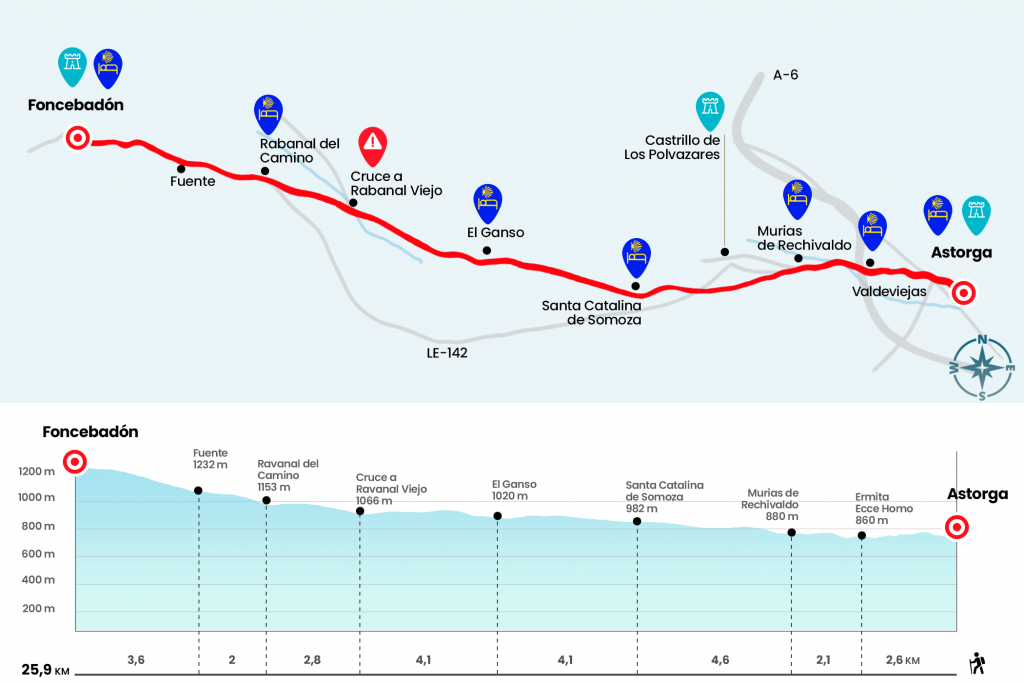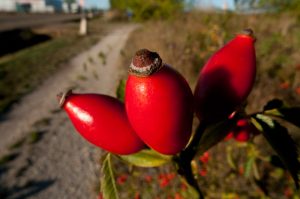Article translated by an automatic translation system. Press here for further information.
Astorga to Foncebadón stage
Road sweetened by Astorga mantecadas and pujaldrados
Information about the stage 21: Astorga to Foncebadón stage

Enlarge map
Points of interest in the stage 21: Astorga to Foncebadón stage
The route
- Km 0. Astorga (All Services)
Due to the large number of confectionery in Astorga, which engages us with their mantecadas and puff advertisements, it is very difficult or, rather impossible, to leave the old Roman city without having tried a single sweet. Having breakfast, turning its back to the facade of the Astorga City Hall, we cross the Plaza Mayor to hang us down Calle Pío Gullón, located on the left of the plaza. After crossing García Prieto, we continue in front of Postas Street and Santiago Street. Leaving aside the Episcopal Palace we went by the cathedral and took Porteria Street - where the private hostel is located. After Goal we folded right and advanced straight about 400 meters down San Pedro Street. We crossed the street for a pedestrian crossing and threw in the direction of Castrillo de Polvazares and Santa Colomba de Somoza along the street of the Martyrs. For a walk parallel to the LE-142 we gently descend to the height of Valdevieja, where is the chapel of the Ecce Homo, a construction of the 18th century that was completely restored in 2007. The hermit madruga, stamps and also facilitates credentials. About 150 meters to the right of the hermitage, on the road leading to Valdevieja, there is a pilgrimage hostel opened in 2010.
- Km 2.6. Transfer to Valdeviejo (Hostel. Bar)
We left behind the hermitage and saved the A-6 motorway (North-West motorway linking Madrid with the Arteixo Coruñesa) for a high pass. An andadero at the foot of the LE-142 awaits us to drive us to Murias de Rechivaldo, a Maragata population that we enter after saving the river Jerga. The 18th-century San Esteban parish is on the right hand and we pass through Murias on a side street, where is the inn and the private hostel.
- Km 4.7. Murias de Rechivaldo (Hostels. Bars)
We left Murias de Rechivaldo through a gravel trail escorted by scrub and brooms. A long line of more than two kilometers leads us to cross the LE-142 (Km 7,3), a road that we leave for a walker stuck to the LE-CV-192. About half an hour later we arrived, ascending very tightly, to the center of Santa Catalina de Somoza. Also old town of Maragatos arrieros, with houses with double leaf portals always painted of some primary color. Several hostels with bar also allow a short break after two hours of walking.
- Km 9.3. Santa Catalina de Somoza (Hostels. Bars)
We cross the population through Calle Real and at the exit we recover the andadero from LE-CV-192 that, again in an almost imperceptible ascent, brings us closer to the population of El Ganso. Between stockings, a wooden cross placed in summer 2012 replaced the old, rather deteriorated cross. In El Ganso, after a couple of bars we turn left to pass by a fountain and the church of Santiago.
- Km 13.4. El Ganso (Hostel. Bars. Store)
After El Ganso, the same script awaits us: the monotony of the walker, which in some sections that are about to arrive is narrow and obliges to walk on the asphalt, although it is also widened by a pine tree. Between El Ganso and Rabanal del Camino, on the bridge of Diaper over the stream of the Reguerinas and next to the Roman mines of the Fucarona, is the tent of the Gaudisse Association. They are a not-for-profit association that fights childhood cancer and fundraise with the donations left by pilgrims when they make a photo with an eagle from the Acceppiter family. They place the seal of the Association and provide information on the stage itself. In front of them have also enabled in a shady area two large banks to rest. We will leave to the right the crossing to Rabanal Viejo and Maluenga (Km 17,5) and, behind the river Rabanal Viejo, we leave the road to take a path that goes up between a bounce. We move on to a fence filled with crosses made with sticks, where some pilgrims stop to put their own. On the left hand was the monumental oak of the pilgrim, known for the nickname of carballo of Fonso Pedredo. A myth of the Jacobean route that was shot down by the wind in November 2013 (Km 19).
Also on the left hand side we leave the chapel of the Cristo de la Vera Cruz, owned by the Junta Vecinal (Km 19,7). We leave the company of LE-CV-192, which merges here with LE-142, to enter Rabanal del Camino. The ninth stage of the Codex Calixtinus departed from León and ended in Rabanal del Camino. From Astorga they mediate only 20.3 kilometres and some pilgrims extend the day five and a half kilometres further to Foncebadón (Ensure first, especially in winter, that hostels in Foncebadón are open). Both those who do night (up to four hostels to choose from) and those who continue will find in Rabanal several inns offering traditional food and good pucheros (Km 20,3).
- Km 20.3. Rabanal del Camino (Hostels. Bars. Store)
We overtake the main street of Rabanal del Camino to reach by a utility room, where we take a runway between the outskirts - cyclists have the option to continue on the road LE-142. There are some sections where you have to push the bike. A kilometer later we cross the road and continue down the left road. We arrived by a watering fountain (Km 22.3).
We climbed a short stretch to the road LE-142, good watchtower to look at the silhouette of Astorga and the maragatry lands. A road that progresses above the road leaves us 3.5 kilometers later in the center of Foncebadón, a town ruined and settled on Mount Irago. Resurrected thanks to the Camino, it has a tavern, a restaurant, the El Trasgu grocery store that has a couple of rooms and several hostels.
- Km 25.9. Foncebadón (Hostels. Pension. Bars. Store)
The difficulties
Remarks
In images
What to see, what to do
The hostels

¿Do you want to send any photo of "The Camino de Santiago"?
If you have any photos of "El Camino de Santiago" that you want to share with us, you can send them to us and enlarge the photo gallery


Forum: What pilgrims think about the Camino de Santiago
See all